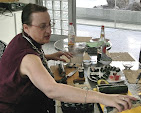The original recipe is from Ouverture de Cuisine by Lancelot de Casteau, published in 1604. The recipe is in French. I have provided a transcription of the French and a translation.
The recipe has two parts. The first is to make sugar paste and then in the second part you incorporate cinnamon and form cinnamon sticks.
The recipe
Pour faire paste de succre.
Prennez du fin succre bien tamizé par vn fin tamier, puis ayez gomme d'aragante bien trempee en eau de rose passée par vn estamine aussi espes que vous le pouuez passer, puis mettez vostre gomme dedans vn mortier de cuiure ou autre & estampez bien vostre gomme, y mettant tousiours vn peu de succre tant que vous faictes vne paste maniable. Notez tant plus est il battu tant plus blanc deuient il: de ceste paste vous pouués former ce que voulez, comme faire en formes cauees, ou des trenchoirs, ou plats, ou tasses ce que vous voulez, & le mettez suer dedans vn four qui ne soit pas trop chaud, vous le pouuez aussi dorer aussi fort que les voulez auoir: gardez bien que le four ne soit point si chaud qu'il face leuer la paste par bontons, cela ne vaudroit rien, car il faut que la paste demeure ferme.Pour faire Caneline.
Prennez vne libure de ceste paste & deux onces de canelle tamizee bien fine, & battez vostre paste dedans vn mortier tant & si longuement que le canelle soit bien encorporee avec le succre, puis vous ferez des couuertures bien tendres la largeur d'vn demy quartier, prennez adonc des bastons la grosseur d'vn doigt, & rollez la paste dessus comme on faict les galettes, puis estant vn peu ressuyé tirés le hors du baston, & le mettez sur le papier, & le mettez suyer dedans le four.
Translation
To make sugar paste.
Take fine sugar well sifted through a fine sieve, then take gum tragacanth well tempered with rose water passed through a strainer as thick as you want it to pass, then put your gum into a mortar of copper or other & grind well your gum, and put therein a little of the sugar until you make a workable paste. Note that the more it is beaten the whiter it will be: of this paste you can form that which you want, like to make in hollow molds, or trenchers, or plates or cups as you want, & put it into an oven that is not too hot, you can also gild it and make it as strong as you want to have: watch well that the oven is no longer so hot that it makes dough rise, that would be worthless, because it is necessary that the paste remains firm.To make Cinnamon Sticks.
Take a pound of this paste & two ounces of cinnamon ground well fine, & beat your paste in a mortar then & long enough that the cinnamon is well incorporated with the sugar, then make the covers well thin the size of a half quarter, take then sticks the size of a finger, & roll the paste like one makes little galettes (crepes), then once a little dry, slide off the end of the stick, & put it on the paper, & put it into the oven.My version
250g icing sugar1 teaspoon powdered gum tragacanth
3 teaspoons rosewater (add more if required)
I didn't want to make as much as a pound of paste, and was working in metric. I decided to use 250g of icing sugar, being the size that a packet of icing sugar comes in, in Australia. Sugar wouldn't have come in this form in the period, however the sugar that was available would have been ground until it was this fine.
There is no guidance as to how much gum tragacanth to use in the recipe. I looked at modern gum paste recipes to see if they would provide any guidance – a typical modern gum paste recipe might use gum tragacanth but with the addition of gelatin, egg whites or maybe corn or glucose syrup. That said I did find a recipe (Lindy's cakes in the UK) that simply said that she used 1tsp of gum tragacanth added to 250g sugar paste.
So I used a teaspoon of gum tragacanth powder, and added about three teaspoons of rosewater. I discovered that what happens when you add rosewater to gum powder is that the gum gels immediately into lumps, not easily dissolved by stirring.
But as the original recipe indicates, passing it through a strainer helped to turn it into an amorphous gel, which could then be mixed with the sifted icing sugar to make a paste.
For 250g of my newly made sugar paste, I kneaded in 31 grams of cinnamon (the proportion in the recipe is 1 pound of paste to 2 oz of cinnamon ie. one eighth). To add verisimilitude to the look, I added a few drops of brown food colouring (this is not in the original recipe – I have found that how dark the paste will be is dependant on the cinnamon – the quality of it, and how newly-ground it is).
Using a rod rolling pin, I rolled the mixture out into thin strips and then rolled them up over skewers, and once dry enough, slid them off on to a rack. Rather than curing in a low oven, I placed them in front of the heater to dry.
I also took the extra step of using some brown food colouring to paint the sticks just lightly to give them more texture and make them look more realistic.
I am delighted with the final look and flavour of the cinnamon sticks, and have served them at a feast where they were received with much pleasure (and some confusion as people thought they were real).










